The wood mushroom is a good edible mushroom with a smell of aniseed found in woods in autumn (US: fall). It is related to the button mushroom and the horse mushroom, than which it is smaller at around 5-10 cm (2-4 inches) in diameter. (If gathering mushrooms you must be absolutely certain what you have before you eat them as many are very poisonous.)
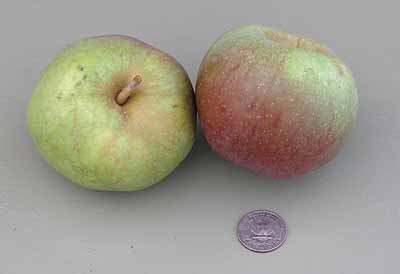
An old name for Baldwin, as was Pecker. A variety of mottled, medium to large, yellow eating apple streaked with dark red and crimson which was found by Mr John Ball on a farm in Lowell, Wilmington in Massachusetts some time around 1740. It was named Pecker or Woodpecker and then renamed in the early in the 1800s. It is a crisp apple with a slightly tart flavour and having a tough skin and yellowish-white flesh. It is a late-season apple, which is picked from mid-October in South-East England is stored and is at its best from December to April. In the United States it is picked in September in warm regions and until November in colder. Baldwin was an extremely popular apple until several million trees were killed off in the severe winter of 1918.
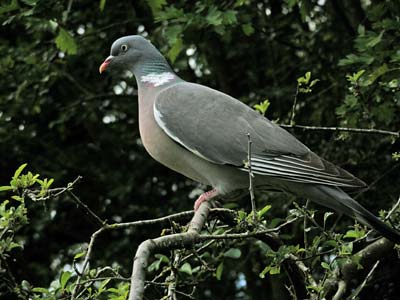
The woodpigeon is a ubiquitous and successful wild pigeon with an iridescent neck, grey head and pinkish breast. A large bird considered by some to be vermin and not worth eating. However, young pigeons or squab, taken when they have started building muscle for flight but before they actually take wing, are a real delicacy.
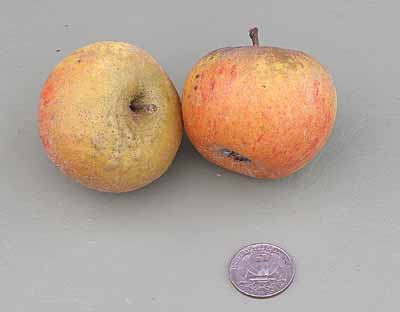
A name for Court of Wick, a variety of russet eating apple flushed blushed with red, which was discovered in Yatton in Somerset at the Court of Wick with Golden Pippin as one of its parents. It is also known as Wood's Huntgindon, because it was introduced commercially by Mr Wood of Huntingdon in 1790. It is a late-season picked from late September in South-East England and is at its best from October until December.
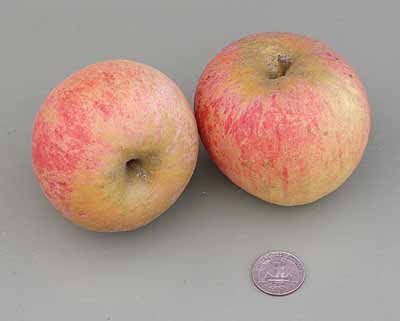
A name for Blenheim Orange, a large, crisp, dry, aromatic, yellowish-fleshed, pippin apple with a sweet, slightly tart flavour and dull, yellow skin washed and speckled with orange-red. It is a good-looking eating apple which cooks well and is preferred in tarte tatin as it is soft-textured but does not lose its shape. It was discovered growing along the wall that was the boundary of the grounds of Blenheim Palace in Woodstock in Oxfordshire around 1740 by Kempster. It was originally named Kempster's Pippin but the name was changed with the approval of the Duke of Marlborough around 1904. It was awarded the Banksian Medal of the London Horticultural Society in 1822. In the 1920s it became widespread throughout Europe and the United States. In France it is known as Bénédictin. A traditional Christmas, mid- to late-season, apple which is harvested from late September to early October in South-East England, is stored and is at its best between October and December. In the United States it is harvested from October to December.

A variety of russet cooking apple raised by JH Stevens & Son at their nursery in Woolbrook at Sidmouth in Devon in 1903 as a cross between Bramley's Seedling and King's Acre Pippin. It received the Royal Horticultural Society Award of Merit in 1930. This late-season variety is harvested from mid-October in South-East England and is at is best in December.
The wolly milk cap is a poisonous mushroom. (If gathering mushrooms you must be absolutely certain what you have before you eat them as many are very poisonous.)
Whole black lentils. They need to be cooked for a long time.
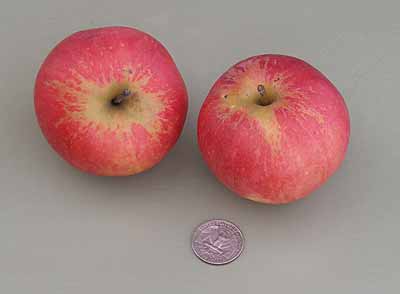
An old variety of eating apple grown since 1873 or 1874. It is a crimson apple which grows on a tree which has grey bark. Its crisp, sweet white flesh is intensely perfumed, with hints of strawberry. The apples should be eaten as soon as they are taken from the tree as they do not keep well, but they are excellent chilled. It arose in the garden of Mr Hale of Swan Pool at St Johns near Worcester and was probably a seedling of Devonshire Quarrenden. It received the Royal Horticultural Society First Class Certificate in 1875 and the Award of Garden Merit in 1993. This early-season apple is harvested from early September in South-East England and has poor storage properties.